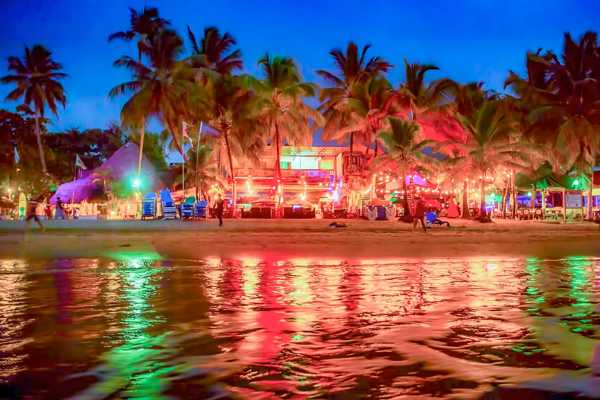This list of things not to do in the Dominican Republic should keep you on the safer side during your trip to this popular Caribbean destination. You’ll likely have a smoother travelling experience by simply avoiding some of the common mistakes people make when visiting this larger eastern half of the island of Hispaniola and clearing some misconceptions beforehand.
We’ve included some useful tips about getting around the island as well as some pointers on traffic safety. We’ve also thrown in some things you ought to know about the local currency as well as weather and climate in this part of the Greater Antilles. Simply bookmark this list to add as a quick reference to your plans for visiting the Dominican Republic.
- 1
Exchanging too many pesos
Just change enough for small purchases

Preferably take dollars with you then exchange them for small amounts of Dominican pesos (RD$) when you’re in the country and as needed. This applies if you’re staying at an all-inclusive resort as they also accept US$. Credit cards are also widely accepted in the Dominican Republic – notify your bank of your travel plans to be on the safe side.
You’ll need some small change in the local currency for things like transport and refreshments. Sometimes, when you pay in dollars at small shops, you’d often get change in RD$. In any case, ensure your notes are in good condition and not scribbled on as most shops won’t accept them. You can also play in US$ at casinos and win in dollars. Play and win in pesos, and you’ll often find it hard to change them to dollars.
- 2
Not arranging for airport transfers
Get to your hotel conveniently

It’s always best to check if your hotel includes airport transfer services with your booking. Included transfers help you avoid the hassle of queuing or looking for a taxi or shuttle once you’ve landed at Punta Cana International Airport (PUJ). You also won’t need to worry about figuring out prices for taxi rides.
Foto de Puntacanaresort (CC BY-SA 4.0) modificada
- 3
Driving
You’ll find roads with hazardous local traffic

Driving in the Dominican Republic can be tempting at times like when you want to escape the confines of your all-inclusive Punta Cana resort and discover on your own what the rest of the beautiful country has to offer. However, note that the traffic will often seem hectic to newcomers, with reckless drivers and motorists who don’t seem to find it chaotic themselves.
- 4
Staying only within your all-inclusive resort grounds
There’s more of the Dominican Republic to see and explore

First-time travellers to the Dominican Republic more likely than not would book their stay in an all-inclusive resort. But there’s more to the country than the confines of modern resort grounds. You’ll miss out on the ‘real’ Dominican Republic, with its various towns, vibrant history, and coastal views.
In each locale, you’ll discover even more beaches or features of natural beauty, and there are often easy excursions available such as boat trips, waterfall tours, and even horseback riding to enjoy. Remarkable colonial architecture awaits in the country’s capital Santo Domingo and there are lush sugar plantations, picturesque villages, and mountain retreats in small towns like Constanza.
- 5
Underestimating the sun (or rain)
Cover up and slap on some sunscreen

When visiting the Dominican Republic, you’ll likely be enjoying plenty of time in the sun. Be careful though, as it’s indeed a sunny country, and it’s easy to get a tan on the beach. But with all the fun, it’s also easy to get sunburnt before you realise it.
Wear adequate clothing and slap some sunscreen onto exposed parts of your body. The effects of the sun’s rays tend to be stronger around the white-sand beaches. You’ll still have plenty of sun beyond summer. To note, June is often the hottest month and August has the most daily sunshine hours.
- 6
Falling for common scams
From fake beggars and police to illegal taxis and parking

Over a third of Dominicans live under the poverty line, and some often resort to committing scams for a quick buck. Those you should be aware of range from easily avoidable ones like fake (professional) beggars and vendors selling fake goods like cigars to shadier practices like bar scams and unlicensed taxis and tour operators.
Being vigilant is key in spotting unlawful tactics. Shady taxis tend to overcharge. Official taxis stick to designated pickup areas. Unlicensed tour operators often offer cheap packages and some ask for bookings paid in full, in advance, but are nowhere to be found on the day of your tour. Beware of inflated (or absence of) prices at restaurants and bars. Always ask for a final price quote for weighed seafood.
- 7
Think everyone speaks English
It’s not widely spoken

Christopher Columbus first landed in Hispaniola in 1492, and the Dominican Republic became a Spanish Colony a year later. The main spoken language in the Dominican Republic remains Spanish. In general, English isn’t very widely spoken. If you know a little bit of Spanish or even speak the language, you’ll face no issues getting about and getting by.
Even so, you’ll be able to communicate in English in the more touristy and recently developed resort areas such as Punta Cana.
- 8
Missing out on Dominican cuisine
Discover cultural influences and exotic flavours

One great way to experience the culture of the Dominican Republic is through the exotic flavours of its cuisine. Dominicans take pride in the variety of their local dishes, which in many ways represent fusions between African, Spanish, and indigenous Taino influences.
Among the treats not to be missed are cativia (wheat empanadas), salpicon (chilled seafood and vegetables), sancocho (rich meat stew), and pastel en hoja (boiled root crops and meat in banana leaf). Some of the more unmissable local dishes include chicharron (fried pork skins) and tostones (fried plantains) as snacks.
- 9
Underestimating the Dominican Republic’s hurricane season
It lasts between June and November

The so-called hurricane season should be factored in when planning a trip to the Caribbean islands. The Dominican Republic itself lies right in the middle of the Caribbean hurricane belt, getting its fair share of stormy weather – usually at its peak in August and September.
Temperatures in the different regions throughout the island of Hispaniola also vary due to the diverse terrain. Take into account where you wish to stay and what types of activities you plan to do during your visit.
- 10
Thinking the cellular coverage is great
You might not be able to use online maps

Using your smartphone for communication and navigation while out and about in the Dominican Republic might not always be a great experience. Most GSM networks work flawlessly in the main towns such as Punta Cana and Santo Domingo, but the more you might get lower signals in rural areas where you’d mostly need your online maps.
You should also consider the high roaming charges when using your home card. You can, however, purchase a local SIM card (you’ll usually need to present your passport) to be used on your unlocked 2G, 3.5G, or 4G LTE-enabled smartphone. Local providers include Claro, Altice Dominicana, and Viva.



















